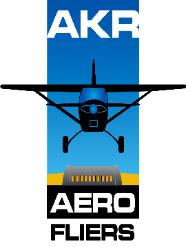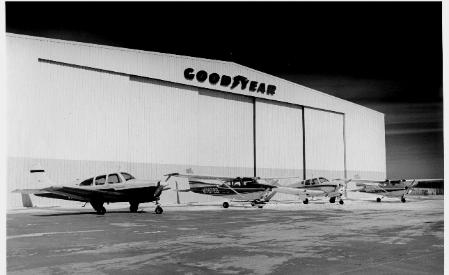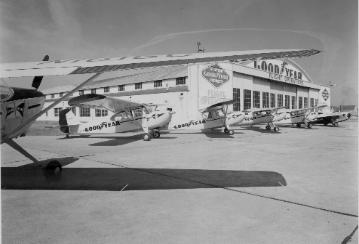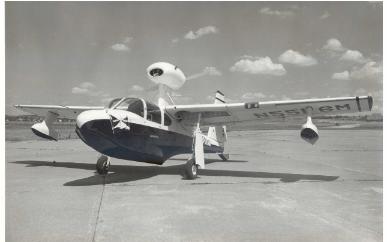 Just months after the start of World War II, Goodyear Tire & Rubber Company created the
Just months after the start of World War II, Goodyear Tire & Rubber Company created the  Wingfoot Fliers as a subsidiary so employees could fly and use aircraft for business. At the time it produced FG Corsairs and the Goodyear Aerospace Corporation manufactured other aircraft and aircraft equipment. The mission then was to offer affordable flying, education and safety.
Wingfoot Fliers as a subsidiary so employees could fly and use aircraft for business. At the time it produced FG Corsairs and the Goodyear Aerospace Corporation manufactured other aircraft and aircraft equipment. The mission then was to offer affordable flying, education and safety.
In the 1980s, the club became its own entity and reformed as the Aero Fliers. Today it has three aircraft, including a 1966 Beech Debonair, which was purchased new and been part of the club ever since. Club President Leonard Dyko and senior member in terms of age and tenure John Malene share Aero Fliers history and some tools for success.
Name: Aero Fliers
Location: Akron Fulton Airport (KAKR), Akron, OH
Website: http://aerofliers.org
Year formed: 1942
Aircraft: 1980C-172 Skyhawk ($100/hr or $91/hr block time), 1986 C-182RG Skylane ($138/hr or $126/hr block time),
1966 Beech Debonair ($170/hr or $155/hr block time)
Rates: Are Hobbs hours, wet. All three aircraft are owned by the club and have Garmin GNS-430. The 182 and Debonair have autopilot. Block time is a reserve members pay into up front and then receive a 10% discount on the hourly rate
Joining fee: $1,000 for the 172, and additional $300 each to fly the 182 and Debonair.
Monthly dues: $90 per month. $120 per year for non-flying members
Membership: 29 active (Cap of 50); There are also 12 inactive members.
Scheduler: Flight Schedule Pro
When was the club formed?
The club was formed in 1942. Chairman of the Board of the Goodyear Tire Company, P.W. Litchfield said, "We are a company that designs airplanes; we build airplanes; we maintain airplanes. I would like to have every club member given the opportunity to learn to fly the darn things." And that’s when he bought the J-3 and it all started from there.
The only way you could join the club was to get a paycheck from some branch of Goodyear. The Goodyear Wingfoot Fliers didn’t take people off the street. It was a totally corporate organization.
 How has it been successful for all these years?
How has it been successful for all these years?
In a nutshell, the core of the whole thing was the organization that was formed by P.W. Litchfield. It’s been a company club for so many years, until they got rid of us in 1986. You had to be somebody to be President, not just a good guy but have some position corporate-wise. I think that was key to the whole thing being formed and maintained as successfully as it was.
Tell me about the club’s purpose.
At our last annual dinner at Christmas, we had the original president when it went from Wingfoot Fliers to Aero Fliers and the purpose statement that those guys had in the very beginning is what we still stick to—Affordable flying with a decent amount of resources—being the complex, retractable, and the high performance. We’re supposed to promote education and number one on our list is to promote safety.
What type of aircraft has the club had over the years?
I’ve got a picture of all the airplanes that were in the club when I joined. There were about 10 or 12 of them; I can’t remember how many. There were two Aeroncas, two Cessna 140s, a Stinson 108, a Piper PA-12, and a Goodyear Duck. That was the club when I joined it in 1954.
 What are your membership fees and dues?
What are your membership fees and dues?
There is a $1,000 initiation fee that allows members to fly the 172. An additional $300 fee allows pilots to fly the 182 and another $300 fee gives pilots access to the Debonair. Monthly dues are $90.
How many members do you have and how many fly the Debonair and 182?
We have 29 active members. We have a cap of 50. Twelve fly the Debonair and I’d say another eight fly the 182, so 20. There are about a dozen non-flying members, which pay $120 a year.
Tell me about your block time reserve?
We’ve had it for the past two or three years. We were trying to get people to fly. We felt the airplanes weren’t being flown enough, so we were trying to throw an incentive in there to encourage people to fly more.
The numbers with block time are the dirt bottom, operating costs. With fuel, we reanalyze it every quarter as far as where our rates are for our aircraft. We occasionally take a hit if the fuel price goes up too much.
How often do you adjust the rates?
It varies. We put a small cushion for fuel, $0.25. If we exceed that we adjust it from there. We’ve been pretty accurate.
How many members participate in the block time?
Over half. It’s truly a mental incentive. You buy the block time and it’s not like you’re paying a check for flying you’ve already done. The money is already spent, so you might as well go use it. Honestly, that was one of the smartest things that the group has done. It’s amazing how many people fly as a result of it.
Do you have some data to compare total hours before and after?
It’s about a 10 to 15 percent increase. We wanted to see how it worked and we were surprised. It truly is an incentive and gets people motivated to fly.
Tell me about the facility and hangar?
We have an entire set of A-Hangars, we have 9 hangars. It came with the whole package when we changed over from Wingfoot. Wingfoot built the hangars, they have electric bi-fold doors, and they paid it off. Now it’s a revenue generator for us. It’s been truly a saving grace for us.
How much do you charge?
$275 a month, and that’s with utilities.
Are the hangars full?
We have two openings right now. We’ve got some local folks interested, but if they don’t want it, they are available and we’ll advertise in our local aviation newspaper.
What are some benefits to joining your club?
The field. The Akron Fulton Airport (KAKR) has two intersecting runways, and it’s non-towered. It has a localizer approach and if you get in a bind, not more than five minutes away is a fully capable Class C airport [Akron-Canton (KCAK)]. Our weather options are much broader than most.
Is that a factor in members joining?
Yes. The next place to go for a flying club is Akron-Canton Airport and it’s far cheaper to exist here than it is there, and it’s non-towered, so getting in and out is easy.
Education is part of your mission. Do you have a lot of members who join without a pilot’s license or get advanced ratings?
Yes. We’ve got one member now that hasn’t flown since the 1970s who is getting back into it, and we’ve got one who is a zero time primary student. And we’ve got a number working on instrument ratings and a couple that are working their way through commercial.
In fact, on the bad weather days, that’s when a lot of the flying happens. Being where we are geographically, we get plenty of good IFR days here.
How many CFIs in the club?
Three. If you train in club aircraft, you have to fly with a club instructor. That’s an insurance requirement.